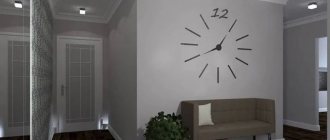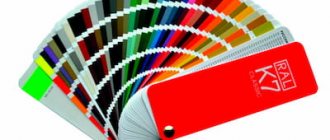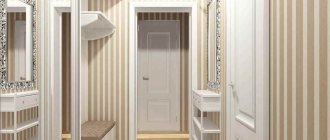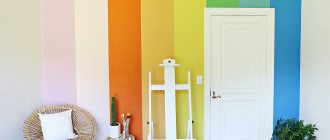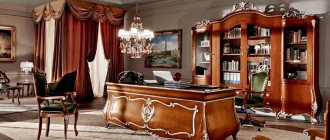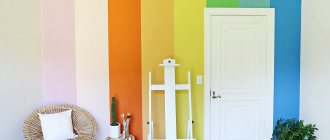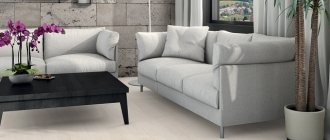The ideal paint color for a small hallway should be fresh, inviting and provide the perfect welcome to visitors. When choosing a range of colors, there are no rules or restrictions. The most important thing is that the shades intersect with the tones of other rooms.
Often the color of the walls is selected depending on the paint of the front door. Calm shades characterize comfort and tranquility, while dark shades give a special character to the interior. What color is best to decorate a small corridor - see below in the article.
If you prefer a classic neutral, dark and atmospheric interior - choose an entryway scheme that reflects your personal personality as well as the style of the rest of the home.
In addition, when choosing a color for a small hallway, you do not need to rely on current fashion trends. They can change every year, but renovating the corridor every year is not the best pleasure.
Color selection criteria
Choosing the right color is especially important since the hallway is typically the first space people encounter when entering a home. Therefore, it should be a fresh and inviting space.
- To visually enlarge a room, it is best to use shiny materials.
- For visual convenience, you should not use more than three colors in the hallway.
- There should be only one neutral tone, other shades can be contrasting.
These rules will help create intrigue and an atmosphere of comfort and homely warmth.
What color to choose for decorating a small hallway
The corridor is by nature a dark room to which sunlight does not have direct access. This is why wall color is so important. He can change the space parameters - visually expand or narrow the room.
Warm shades are optimal for dark hallways - they lighten and visually expand a narrow corridor: yellow, peach, orange, cream and vanilla.
You can also choose cool colors: beige, blue, light green, white and gray shades.
If the corridor is small and rectangular, you can use optically increasing colors on the walls, that is: shades of yellow, bright orange, bright blue, green and aquamarine tone.
White doors and ceilings will add lightness to the interior and increase the impression of spaciousness.
Bright colors
They look great in a square hallway. To expand it, it is recommended to cover the walls perpendicular to the entrance: purple, green, beige, and the opposite walls with a dark shade.
More: How to comfortably arrange a small hallway
If you need to optically lower a high ceiling, you can paint it the same tone or slightly darker than the walls, for example, it can be bright blue with light blue walls. It is also recommended to use white on the fronts of the doors and a light floor - this will further expand the room.
Combination of shades of the same color
Designers recommend painting the walls and doors in a small hallway alternately with two shades. This will divide and interestingly diversify a small space.
Color harmony
The color of the walls in the hallway should match the color of other interiors. This is especially true when the corridor is not a separate room, but is completely or partially open to the living room.
You shouldn't paint everything in the same tone - it's boring. It’s worth breaking it up with bright colors or decorative elements:
- paintings;
- mirror frames;
- wall decorations;
- flowers.
These details are great for adding variety to your hallway interior. Playing with colored, light, hanging shelves and arranging hangers can bring extremely interesting effects. It all depends on color preferences and lifestyle.
Black and white
This set of colors fits perfectly into a small corridor, even a very narrow one. And if you choose a hallway in shades of wood, you need to take care of the lighting so that the hallway is warm, so that it does not become gloomy and overloaded with wooden accessories. They can be diluted with aluminum elements.
Colorful ideas
The combination of intense shades is guaranteed to bring a luxurious character to the corridor. Don't be afraid of bold hues - it's all about ensuring they harmonize by choosing tones that can compete equally.
You can use a dark color on the lower half of the wall to keep the hallway feeling spacious.
Peach
If you're not up for a bold clash, you can still experiment with contrasting shades and color blocking, keeping the look neutral with an off-white scheme and nearly matching tones.
Peach tones look stunning when paired with white paint and rich-grained mid-tone wood.
Tip: When shopping for hallway paint, look for brands that offer the same range of wood and wall colors to find the perfect match.
Accent with line
You can add even more interest to a two-tone hallway by painting a sleek black horizontal line. Paired with gray and pink paint, black creates a casual, elegant finish, neatly tying the color scheme together.
Green
The most relaxing of colors, making it ideal for a busy family hallway. Lighter shades also work wonders for visually expanding small spaces, especially when paired with a bright white hue.
In this hallway, the subtle sage color against the white walls creates depth and the impression of space, plus it neatly ties into the color scheme of the room beyond.
More: Scandinavian style hallway interior
Red
This is a bold paint color choice for a small entryway, but it can look really good if you choose a subtle shade and pair it with more muted colors for the doors, floors, and woodwork.
We select wallpaper to match light-colored doors. Selection of photos
Color is one of the most important parameters in the renovation industry. Many factors important in the interior of a room depend on it. This includes the visual expansion of space, the amount of light and its dispersion, and the overall design of the room and its style. So you should never forget about color!
Color is one of the most important parameters in the renovation industry. Many factors important in the interior of the room depend on it
In general, entrance doors in light colors are a rather bold solution, which five years ago was unique and rarely found in city apartments. After all, not every person will decide on such a bold design decision. One of the main difficulties faced by people who have a light-colored door in their hallway is choosing the best color scheme. In this section of our article we will try to understand this issue in detail and help you make a choice.
Silver wallpaper in the hallway will benefit the interior
See alsoWhite doors in the interior
The influence of color on the proportions of space
Colors are known for creating the climate of an interior. Some of them effectively warm up sterile landscapes, while others increase the feeling of cold. There is another potential in their power - the right colors can change the proportions of a room.
Designers and architects are capitalizing on these possibilities, transforming cramped and narrow rooms into spaces that appear much larger than they actually are.
Floral patterns are back in fashion: examples
Floral ornament is a design option that will never go out of fashion and you certainly shouldn’t forget about it. Look at photo examples and get inspired to create your own unique ideas!
Floral ornament is a design option that will never go out of fashion and you certainly shouldn’t forget about it.
See alsoWallpaper for the hallway under dark doors: basic rules for selection and combination
Colors for a narrow hallway
The color palette seems limited in small, narrow and often windowless rooms, and the layout - due to a poor range of tones - is dull and formulaic. In such interiors, both light and dark shades are suitable - provided they are used correctly.
The general rule is that cool pastel shades of blue, mint, gray and white will reflect light and thus optically enhance the area. They are recommended to be used where we want to visually add a few centimeters to the interior.
The colors will “separate” longer walls from each other and give the decor a fresh, light feel. Warm beige, sandy yellow, lilac or powdery pink, in turn, will bring the surfaces closer and absorb light. With their participation, the decor will become more comfortable.
The effect of absorbing and reflecting light, and therefore visual magnification or reduction, can also be achieved with the right finishing.
Matte colors will absorb light. Such coatings do a good job of masking surface unevenness or covering rough spots and streaks, and do not highlight coloring errors. On the contrary, in the case of satin or semi-matte alternatives, which will highlight any imperfections, but on the other hand they will improve the proportions of the interior, bring out the depth of dark tones and reflect rays of light, guaranteeing the impression of spaciousness.
Dark colors
They are supposed to be reserved only for owners of spacious apartments, but their presence in a narrow hallway should not be overwhelming.
Painting the parallel, farthest walls bottle green, dark blue or even black will visually reduce the proportions of the room. A similar result can be achieved when we cover one of the longest walls with the same rich shade as on the floor.
Wallpaper design in the hallway for light doors. Ten examples in the interior. Selection of photos
Hallway renovations are usually started at the very last stage. At the moment when all other finishing and repairs in other rooms are completed. This is due to the fact that all construction waste, which inevitably appears during the renovation process, is carried out through the hallway. When cleaning it, you can touch the walls, stain them, scratch or tear the wallpaper pasted on them. It would be a shame if this ruined the entire new renovation in the hallway.
Wallpaper in pastel colors is perfect for a hallway with light doors.
People who are just beginning to master all the intricacies of finishing work and design may have questions. For example, “What wallpaper is suitable for light-colored doors in the hallway,” “Is a floral pattern appropriate or is it better to use the newfangled geometry of lines and shapes?” Don’t worry about it, because now we will tell you everything in detail and even show you. Look at the selection of photo examples with successful design ideas and get inspired!
Wallpaper with a picture of a city will look interesting
See alsoLight doors in the interior
Color combination
A good idea for decorating a narrow corridor is a combination of shades with the same temperature, with varying degrees of saturation, as well as a composition of shades adjacent to each other on the color wheel.
This gradation will be especially beneficial in a small hallway. On the opposite side, you can use the darkest option: coffee brown or granite tones. In turn, the ceiling, floor and furniture should be light, this balances the contrast.
More: Decorating a hallway in avant-garde style
In color combinations - in addition to choosing the right shades - proportion is also important. If we choose three shades, it is recommended to distribute them at 70% (neutral), 20% (complementary) and 10% (contrast).
In the case of two, the dominant main tone (70%) is complemented by an accent color (30%). Thanks to this, chaos can be avoided, and the decor will be in perfect harmony.
How to visually lower or raise the ceiling
Interior design dilemmas accumulate when, in addition to narrow planes, ceiling height poses a significant challenge. If the hallway is low, it is recommended to choose vertical stripes or cover the ceiling surfaces with a lighter color - for example, white, blue or soft gray.
The chosen shade should be slightly thinner than on the walls, this will create the illusion of increasing the distance between the ceiling and the floor. The resulting impression of “lifting” will be enhanced if the tonality passes to the walls in the form of a strip about a dozen centimeters thick.
In high interiors, you can also use drawing tricks that will align the proportions of the four corners and lower the ceiling.
- The first method involves the use of horizontal stripes, the task of which is to optically expand the room.
- The second is to cover the ceiling with a darker shade than on the walls. Thanks to this, the room becomes not only lower, but also more comfortable.
How to visually change the proportions of a corridor
An effective way to change the proportions of a hallway is vertical stripes. They give the interior elegance and lightness, and also “lengthen” it. This will look good where the ceiling is lowered or the arrangement has a touch of sophistication.
For this reason, vertical lines often emphasize a glamorous, vintage or retro style. In turn, horizontal stripes optically expand the surfaces and increase the depth. When used on a shorter wall, they are the perfect tool for masking imperfections in a narrow room or long hallway.
Small and wide stripes are an extremely decorative element, so it is best to choose them on one, maximum two walls, and reduce the contrast with pastel, harmonizing or monochrome colors. This will prevent the decor from becoming overwhelming while highlighting surfaces and turning them into eye-catching features.
Conclusion
Colors affect more than just mood. In addition to their decorative and psychological function, they also effectively cope with complex surfaces, such as a narrow hallway, a small area, a high or low ceiling.
Choosing the right tone and its application in a certain plane will be a panacea for internal ailments. Light colors will optically enlarge a small corridor, dark colors will add depth, and stripes will expand the wall, lower or raise the ceiling. Using the designers' recommendations, you can enjoy the cozy interiors of small corridors.
